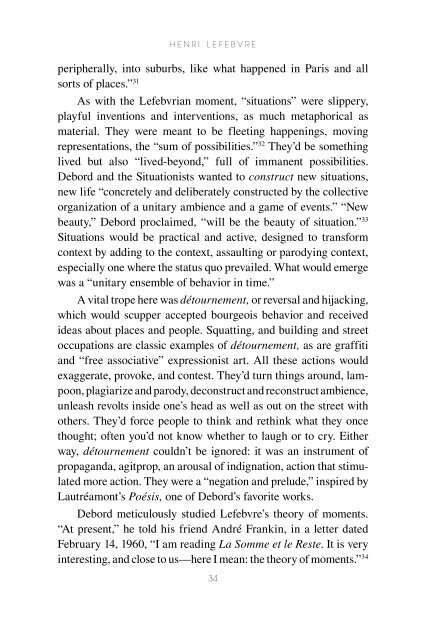Henri Lefebvre: A Critical Introduction - autonomous learning
Henri Lefebvre: A Critical Introduction - autonomous learning
Henri Lefebvre: A Critical Introduction - autonomous learning
Create successful ePaper yourself
Turn your PDF publications into a flip-book with our unique Google optimized e-Paper software.
H e n r i L e F e b v r e<br />
peripherally, into suburbs, like what happened in Paris and all<br />
sorts of places.” 31<br />
As with the Lefebvrian moment, “situations” were slippery,<br />
playful inventions and interventions, as much metaphorical as<br />
material. They were meant to be fleeting happenings, moving<br />
representations, the “sum of possibilities.” 32 They’d be something<br />
lived but also “lived-beyond,” full of immanent possibilities.<br />
Debord and the Situationists wanted to construct new situations,<br />
new life “concretely and deliberately constructed by the collective<br />
organization of a unitary ambience and a game of events.” “New<br />
beauty,” Debord proclaimed, “will be the beauty of situation.” 33<br />
Situations would be practical and active, designed to transform<br />
context by adding to the context, assaulting or parodying context,<br />
especially one where the status quo prevailed. What would emerge<br />
was a “unitary ensemble of behavior in time.”<br />
A vital trope here was détournement, or reversal and hijacking,<br />
which would scupper accepted bourgeois behavior and received<br />
ideas about places and people. Squatting, and building and street<br />
occupations are classic examples of détournement, as are graffiti<br />
and “free associative” expressionist art. All these actions would<br />
exaggerate, provoke, and contest. They’d turn things around, lampoon,<br />
plagiarize and parody, deconstruct and reconstruct ambience,<br />
unleash revolts inside one’s head as well as out on the street with<br />
others. They’d force people to think and rethink what they once<br />
thought; often you’d not know whether to laugh or to cry. Either<br />
way, détournement couldn’t be ignored: it was an instrument of<br />
propaganda, agitprop, an arousal of indignation, action that stimulated<br />
more action. They were a “negation and prelude,” inspired by<br />
Lautréamont’s Poésis, one of Debord’s favorite works.<br />
Debord meticulously studied <strong>Lefebvre</strong>’s theory of moments.<br />
“At present,” he told his friend André Frankin, in a letter dated<br />
February 14, 1960, “I am reading La Somme et le Reste. It is very<br />
interesting, and close to us—here I mean: the theory of moments.” 34<br />
34
















